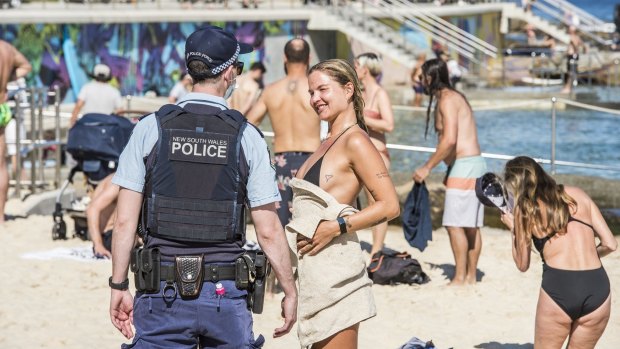This was published 2 years ago
Australia a 'prison island' due to COVID-19 rules? Things have changed, but reputation remains

Police patrol Bondi Beach during COVID-19 restrictions last year.Credit: Steven Siewert
The first time I left my mask in the car, rather than in my pocket, waves of terror pulsated through me. Going by Australia's international standing for COVID fusspottery, this could have been a real problem. Probably worthy of a 14 day stint with the ghost of Novak Djokovic in a windowless quarantine cell or something equally grim.
It's two-and-a-half years since I was last in Australia. During that pandemic-enforced absence, Australia's reputation for happy-go-lucky breeziness has taken a pummelling. The country's COVID response was among the toughest, with former Foreign Affairs minister Alexander Downer among those labelling Oz as a "prison island".
Lengthy lockdowns, shutting out citizens based overseas and battening down the borders made Australia look rankly unapproachable.
It's the sort of background that can make an accidentally maskless trip to a small regional shopping mall pretty fearsome. The revelatory moment came when no-one seemed to bat an eyelid.
In the UK, where I live, this is standard. I put a mask on while shopping almost as a reflex more than anything else these days, and I am very much in a minority. The UK is "living with COVID", which basically means entirely ignoring it while vast swathes of the workforce repeatedly fall ill.
What many in the UK probably don't realise, however, is that Australia is also "living with COVID". Not in quite such a frivolous, slapdash manner, granted, but the days of perma-lockdown are long gone.
Getting into Australia is now more of a mild nuisance than a nigh-on impossibility. The eVisitor subclass 651 visa forms take a bit of filling in, but they were approved instantly. Taking a PCR test three days before departure was terrifying given COVID's merry rampage through the children's school, but the test requirement was removed on April 18.
The Digital Passenger Declarations, meanwhile, are an instrument of torture, just about withstandable with adequate application of heavy swearing.
Essentially, if you're vaccinated and don't let the admin grind you down, it's easy enough to get into Australia these days.
Not entirely helpfully, all the states have slightly different COVID-related entry requirements. Landing in Melbourne, we had to go straight to our hotel and conduct a lateral flow test. Bringing one in the suitcase seemed much easier than trying to tee one up once in the country.
However, the great state of Victoria seemed supremely uninterested in us proving we had tested negative. There was no obligation to report unless positive, and the more unscrupulous visitor could basically get away with not doing the test at all.
Other people are checking things, however. Or at least they are within spitting distance of Melbourne. On Phillip Island, the starting point for our three week road trip, venues were mostly – but not entirely – diligent about checking vaccination status. Essentially, you have to fiddle about on your phone for the NHS COVID Pass before being allowed into a restaurant.
Enforcement on this got considerably more lax as we headed further east along the Gippsland coast. And by the time we hit the New South Wales South Coast, there were few indicators that COVID had ever existed.
Posters requesting QR code check-ins outside venues were routinely ignored. They felt like souvenirs from a bygone era, or atmosphere-building tat like those old beer promo posters that pubs sometimes put on the walls.
Mask-wearing felt like an affectation, too, like sporting a cravat or donning a beret. Our sample of regional restaurants, cafés and supermarkets had mask-wearers at about 15 per cent.
This increased somewhat in Sydney, although even on public transport where masks are mandatory, it struggled to push 30 per cent.
Most of Australia's remaining COVID restrictions seem to be in name only, and widely ignored. Which probably explains why COVID rates are chalking up some big numbers on the graphs right now.
Is the prison island reputation justified, then? A few months ago, maybe. Right now, not at all. Most overseas visitors will probably be able to travel the country for three weeks, never quite sure what the rules are, and wondering whether the signs and posters are leftovers that people have forgotten to take down.
However, it may take a while for this to filter through. When I told friends at home we were going to Australia, the general reaction was surprise it was even possible.
I was obsessively checking border restrictions way before the borders opened and Tourism Australia launched its current marketing campaigns. So, I knew Oz was open. But I did expect high levels of faff. In the end, I got the opposite – a nagging feeling that things have relaxed a little too much.
It felt suspiciously like the pre-pandemic Australia I've long loved. And that's probably a good thing, right?
See also: Already had COVID? What you need to know about travelling overseas
See also: Worried about catching COVID overseas? Here are the safest countries to visit
Sign up for the Traveller newsletter
The latest travel news, tips and inspiration delivered to your inbox. Sign up now.